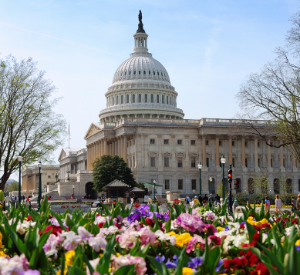A critical first step in understanding retirement benefit adequacy is collecting individual data from priests by conducting a pension plan survey. Since 2011, GRS has deployed a pension plan survey to priests in 15 dioceses. The survey has been proven to be an important tool to help the dioceses understand their priests’ retirement readiness.
NASRA Updates Brief on State and Local Government Contributions to Statewide Pension Plans for Fiscal Year 2018
Industry News
NASRA Updates Brief on State and Local Government Contributions to Statewide Pension Plans for Fiscal Year 2018
In April 2020, the National Association of State Retirement Administrators (NASRA) updated its issue brief, State and Local Government Contributions to Statewide Pension Plans: FY 18. The brief includes: 1) a brief history of public pension contributions; 2) recent public employer contribution experience; and 3) how governance structure may impact funding experience.
According to the brief, “[On] a national basis, contributions made by employers – states and local governments -in 2018 accounted for nearly three-fourths of all contributions received by public pension plans…. [Of] the $8 trillion in public pension revenue since 1989, 37 percent, or approximately $3 trillion, came from contributions paid by employers and employees.”
On average, employer contributions to public pension plans continue to be a small percentage of state and local government spending. In recent years, employer contributions have been growing. Among the statewide pension plans included in the study, the aggregate public employer contributions increased from $102.9 billion in Fiscal Year (FY) 17 to $116.7 billion in FY 18, up 13.4%.
According to NASRA, “FY 18 marked the sixth consecutive year of increase on a dollar-weighted basis – from 93.3 percent in FY 17, to 97.4 percent – in the percentage of required contributions paid by public employers. This improved funding effort occurred even as the rate of increase in required contributions grew at its fastest pace since FY 11.”
Furthermore, NASRA cited that, “Following the recession of 2007-09 and the market decline of 2008-09, many public pension plans have made changes to their funding policies and practices that have produced increases in required contributions in subsequent years, including implementation of more conservative (aggressive) funding policies; lower investment return assumptions; updated mortality assumptions; and reduced amortization periods.”
For the individual plans included in the analysis, the brief also provides an appendix with the basis of employer contributions and contribution history for FY 01 to FY 18. The analysis utilizes four classifications of employer contributions: 1) Actuarially Determined Contributions; 2) Fixed Contribution Rates; 3) Actuarially Determined Contributions with Limitations; and 4) Other Methods for Determining Employer Contributions.
The brief is available here.
Peterson-KFF Health System Tracker Reports on How Health Costs Might Change with COVID-19
Industry News
Peterson-KFF Health System Tracker Reports on How Health Costs Might Change with COVID-19
On April 15, 2020, the Peterson-Kaiser Family Foundation (KFF) Health System Tracker released its brief, How Health Costs Might Change with COVID-19. Due to the coronavirus spreading across the U.S., private health insurers and government health programs may potentially incur increasing health care costs. However, there are numerous unidentified pending issues, such as: 1) the extent to which costs increase; and 2) how the costs are distributed among payers, programs, individuals, and geography. In addition, the brief discusses changes in health care costs due to the coronavirus pandemic as well as various factors that may impact health costs. The brief also presents special considerations for private insurers, Medicare and Medicaid programs.
The brief is available here.
GASB Proposes Postponing Effective Dates of Certain New Reporting Requirements
Industry News
GASB Proposes Postponing Effective Dates of Certain New Reporting Requirements
On April 15, 2020, the Governmental Accounting Standards Board (GASB) released a proposed statement entitled Postponement of the Effective Dates of Certain Authoritative Guidance. The proposed statement was issued in response to requests from stakeholders due to the impact of the COVID-19 pandemic on financial reporting activities. The primary objective is to provide temporary relief from certain new accounting and financial reporting requirements to state and local governments for fiscal years 2019 and later. The proposal would postpone by one year the effective dates of certain provisions in Statements and Implementation Guides, which (among others) includes the following pronouncements:
- Statement No. 84, Fiduciary Activities
- Implementation Guide No. 2017-3, Accounting and Financial Reporting for Postemployment Benefits Other Than Pensions (and Certain Issues Related to OPEB Plan Reporting), Questions 4.85, 4.103, 4.108, 4.109, 4.225, 4.239, 4.244, 4.245, 4.484, 4.491, and 5.1–5.4
- Implementation Guide No. 2019-2, Fiduciary Activities
The Exposure Draft is available here.
CRR Analyzes Local Governments Offering Retirement Benefits Outside of Pension Plans
Industry News
CRR Analyzes Local Governments Offering Retirement Benefits Outside of Pension Plans
On April 14, 2020, the Center for Retirement Research at Boston College (CRR) released its issue brief, Have Local Governments Shifted Away from Traditional Defined Benefit Plans? The brief indicated that the predominant type of public sector retirement plan is a traditional defined benefit (DB) plan. As compared to changes at the state level, CRR analyzed the extent of local governments considering the adoption of alternative plans to shift away from traditional defined benefit (DB) structures. In 2018, 19% of large localities offered a DC, cash balance, or hybrid plan for new hires rather than a stand-alone DB plan, up from 11% in 2001.
According to CRR, “The analysis indicates that retirement plan shifts at the local level are similar to states’ changes in volume and geography, but not in the types of plans introduced. States tend to offer hybrid retirement plans, while localities tend to choose stand-alone defined contribution (DC) plans.”
Other key findings include:
- Self-administered city and county plans are more likely to switch to a hybrid plan or DC plan model in states where alternative plan designs have been used by the state-run plans.
- Although contributions to the new DC plans are lower than those made to the prior DB pension, the impact on government costs will likely be gradual since shifting to a new plan typically applies only to new employees.
- Importantly, the employees covered under the new alternative plans are at risk of receiving lower benefits than under the prior DB pension plans particularly if investment returns fall short of the DB plans’ actuarially assumed return.
The brief is available here.
SLGE Releases Survey Report on Public Sector Financial Wellness Programs
Industry News
SLGE Releases Survey Report on Public Sector Financial Wellness Programs
On April 13, 2020, the Center for State & Local Government Excellence (SLGE) released its survey report, A Focus on Public Sector Financial Wellness Programs: Employee Needs and Preferences. The report summarizes the results of a national survey of over 500 state and local government employees to assess their needs and preferences related to employer-based financial literacy and financial education programs. According to the SLGE, the survey indicates that enhancing the financial literacy and financial education programs by public sector employers for their workforce is not only needed, but would be highly valued by state and local government employees.
The key findings include:
- 88% of survey respondents are worried about their finances and financial decisions;
- 29% of respondents are offered a financial literacy or financial education program by their employer;
- Of those, 38% have participated in the program and 67% the majority were satisfied with the program;
- 68% of respondents would likely participate in a financial wellness program if offered;
- 66% of employees are interested in retirement planning, 39% in investments, and 23% in budget and planning; and
- 87% of employees want to be more knowledgeable about finances, 51% want to know more about financial topics beyond those related to their job, and 45% are interested in the rewards or financial incentives offered for participating.
The report is available here.
Kaiser Family Foundation Publishes Summary of Health Provisions in the CARES Act
Industry News
Kaiser Family Foundation Publishes Summary of Health Provisions in the CARES Act
On April 9, 2020, the Kaiser Family Foundation (KFF) published its report, The Coronavirus Aid, Relief, and Economic Security Act: Summary of Key Health Provisions. The Coronavirus Aid, Relief, and Economic Security Act (CARES Act) was signed into law on March 27, 2020. The CARES Act contains numerous health-related provisions focused on the COVID-19 outbreak in the U.S. as well as support for the global response. Some of the key health provisions highlighted in the summary include paid sick leave, insurance coverage of coronavirus testing, nutrition assistance, and other programs and efforts.
The summary is available here.
CRS Releases Report on Retirement and Pension Provisions in the CARES Act
Industry News
CRS Releases Report on Retirement and Pension Provisions in the CARES Act
On April 1, 2020, the Congressional Research Service (CRS) released its report, Retirement and Pension Provisions in the Coronavirus Aid, Relief, and Economic Security Act (CARES Act). The CARES Act contains several provisions that cover pension plans, retirement plans and Individual Retirement Accounts (IRAs).
As summarized in the CRS report, the CARES Act includes (among other provisions): 1) an exemption to the 10% tax penalty for early withdrawals from retirement accounts for individuals affected by COVID-19; and 2) one-year relief from Required Minimum Distributions (RMDs) for all retirement plan account holders.
The report is available here.
April 2020
IN THIS ISSUE
• Pension Plans Legislative and Agency Update
• SECURE Act Impact on Governmental Plans
• Actuarial Assumptions Cases Update
• Congress Passes Two Significant Relief Measures Addressing COVID-19 Pandemic
• Recent Health-Related Tax Changes
• Health Litigation Update: Texas v. United States

